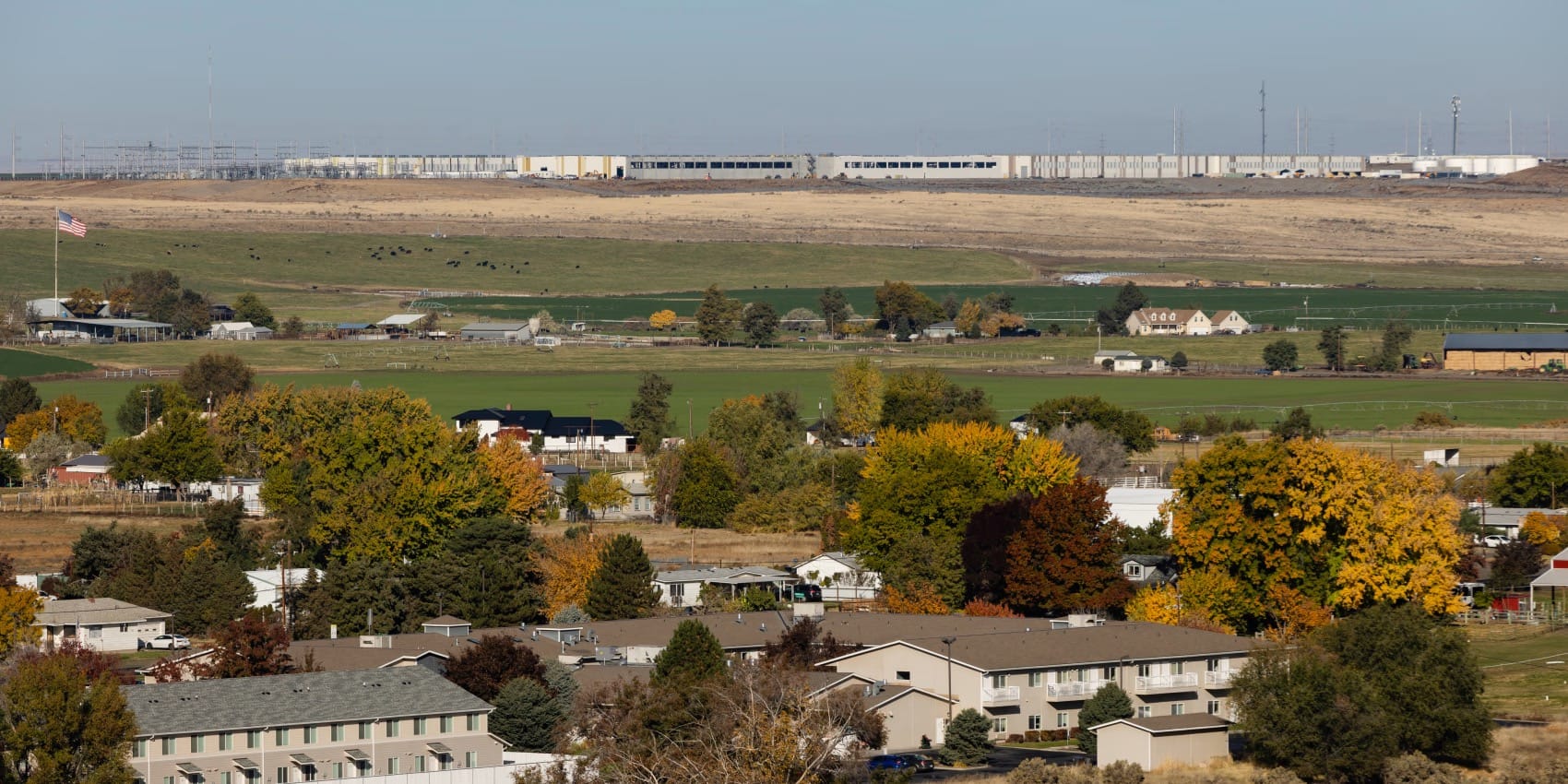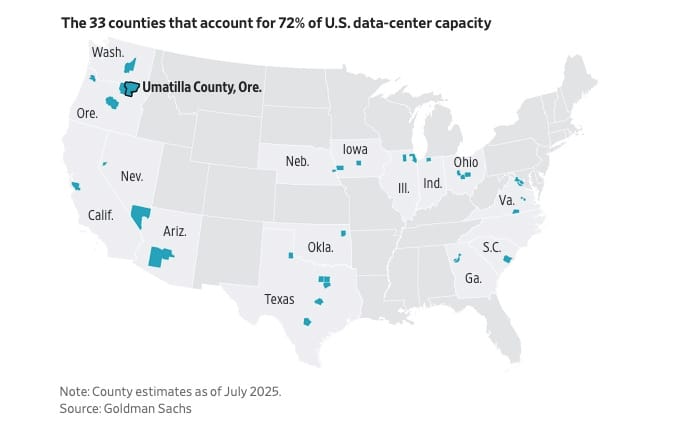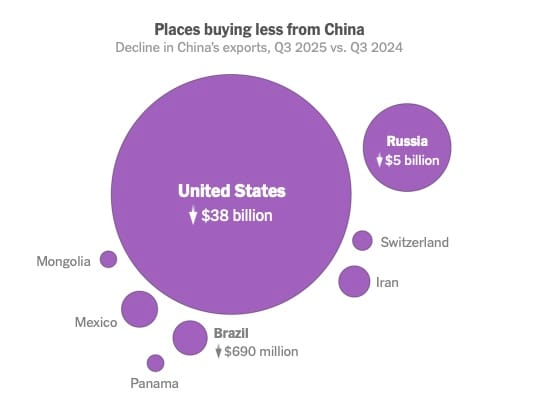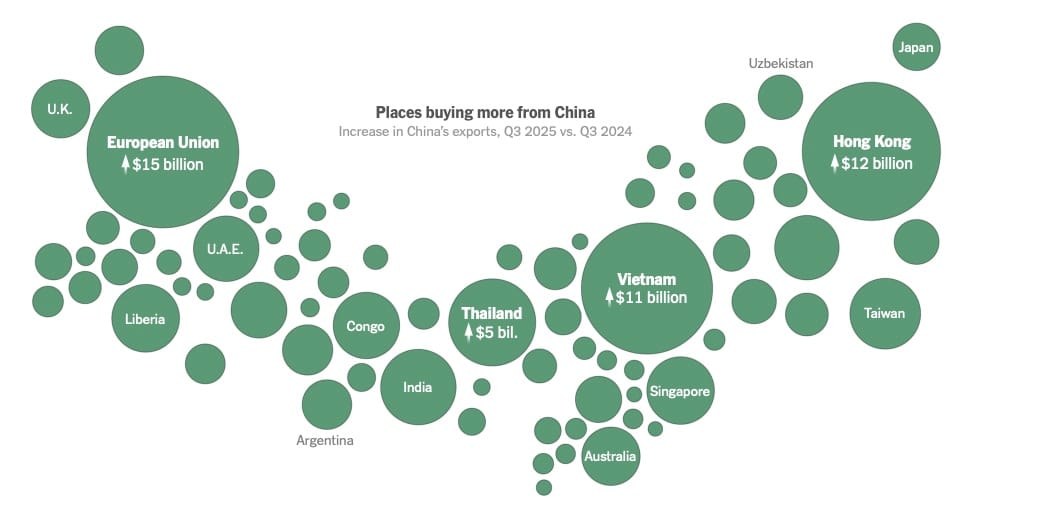Top 5 US news stories
November 4 2025

Tech's 'Hyperscaler' Build-Out Reshapes Rural America, Minting New Fortunes
Court Orders SNAP Payments; Admin to Provide Partial Benefits Using Depleted Fund
Government Shutdown Poised to Become Longest in U.S. History This Week
Rick Perry Startup Aims for Nuclear-Powered AI Hub, But Starts With Natural Gas
U.S. Tariffs Cut Imports, But Rest of World Buys More From China Than Ever

…US GOVERNMENT SHUTDOWN ENTERS 35th DAY, TYING LONGEST SHUTDOWN IN US HISTORY…
...BREAKING...DICK CHENEY DEAD AT 84...
1. Tech's 'Hyperscaler' Build-Out Reshapes Rural America, Minting New Fortunes
UMATILLA, ORE.—Yesenia Leon-Tejeda, like many people on the frontier of America’s tech boom, is basking in newfound prosperity. Her hometown in northeast Oregon was not long ago known for a former chemical-weapons depot nearby, a state prison on the city’s outskirts and the strip clubs once dotting its main drag. But a growing fleet of Amazon data centers has turned the region around Umatilla into an unlikely nerve center for one of the most expensive infrastructure build-outs in U.S. history. The tech giant has pumped jobs, people and money into the community of roughly 8,000, doubling many home prices and enticing builders to etch new neighborhoods into surrounding hillsides. That means dollar signs for Realtors like Leon-Tejeda. The daughter of Mexican-born farmhands, Leon-Tejeda worked 12-hour shifts at a distribution center before qualifying for a real-estate license. Now, she is on pace to close 35 deals this year. The 35-year-old aims to raise her kids in a soon-to-be-built house overlooking the Columbia River and has her eye on Airbnb investments to cash in on the region’s growth. America’s tech build-out has minted millionaires in Silicon Valley, helped a record-breaking stock market defy gravity and buoyed an otherwise uncertain U.S. economy. Investment in software and information-processing equipment drove most of America’s GDP growth in the first half of 2025, according to federal data. The top five tech giants—known as hyperscalers in the data-center world—total more than a third of all S&P 500 capital expenditures. Companies are throwing money at digital innovation to become more profitable with fewer workers down the road. But the sheer scale of investment has obscured how it is already reshaping America, in the form of windowless buildings the size of multiple football fields where businesses store and process information. That development is injecting vast sums of cash into sometimes unexpected corners of the country—many of them bypassed by previous boomtimes. The avalanche of money, which most recent federal data put at $41 billion in annual investment, isn’t spread evenly. Goldman Sachs estimated roughly 72% of all server-farm capacity sat in just 1% of counties as of July.

WSJ
2. Court Orders SNAP Payments; Admin to Provide Partial Benefits Using Depleted Fund
The Trump administration told a federal judge on Monday that it will deplete the Supplemental Nutrition Assistance Program contingency fund to provide food stamp recipients with part of their monthly benefits. Late last week, U.S. District Judge John McConnell ordered the administration to use contingency funds and either fully or partially fund November payments, demanding an update on the administration’s compliance by noon on Monday. The Trump administration told McConnell it would use all $4.65 billion of the remaining contingency funds to pay for partial benefits for November, saying in a filing to the court on Monday that it would not tap into other funds to make full SNAP payments.
Washington Examiner
3. Government Shutdown Poised to Become Longest in U.S. History This Week
WASHINGTON — The lengthy standoff between President Donald Trump and congressional Democratic leaders is poised to become the longest government shutdown in American history this week. Election Day on Tuesday, when voters will head to the polls in Virginia, New Jersey and New York, will tie the record for the longest shutdown. If the shutdown continues into Wednesday, which lawmakers believe is almost certain, it will shatter that record, set during Trump's first term. That 35-day federal closure in late 2018 and early 2019 resulted from a fight over Trump’s demand for a border wall, which Democrats refused to fund. It's a testament to the current political environment that some senators aren't even shocked. Though Congress has shown no signs of a deal, some senators indicated Monday that progress was being made behind the scenes. The painful impacts from the shutdown are now coming into clearer focus. Hundreds of thousands of civilian federal workers are not getting paid, forcing many to turn to local food banks to feed their families. Meanwhile, flight delays are growing worse around the country due to air traffic controller and TSA agent staffing shortages. And 42 million Americans who rely on federal food benefits through SNAP will receive only about half of their monthly benefit in November.
NBC News
4. Rick Perry Startup Aims for Nuclear-Powered AI Hub, But Starts With Natural Gas
Former Energy Secretary Rick Perry’s $17 billion startup aims to build four large nuclear reactors in the Texas Panhandle to fuel AI data centers—eventually. For now, it is sticking with good old natural gas. Fermi , which was co-founded by Perry, is betting on an era of soaring electricity demand. The company went public at the beginning of October and has positioned itself at the crossroads of two crazes: the build-out of more data centers to power artificial intelligence and a potential U.S. nuclear-power resurgence. Fermi, which hasn’t yet generated any revenue, intends to build what would become one of the world’s largest data-center campuses by 2038 at its site in Amarillo, Texas. It will be powered by 11 gigawatts of electricity, roughly the capacity of states like Alabama, Nebraska and New Mexico. Perry—the former Texas governor, presidential candidate and energy secretary during President Trump’s first term—frames the challenge of powering AI as a matter of defending Western civilization.

WSJ
5. U.S. Tariffs Cut Imports, But Rest of World Buys More From China Than Ever


As President Trump has imposed steep tariffs on China, American importers are buying much less. But the rest of the world is making up the difference, buying more from China than ever. China has offset the decline from America with breathtaking speed. Shipments to other parts of the world have surged this year, demonstrating that China’s manufacturing dominance will not be easily slowed. Chinese exports are on track to reach another record this year. That’s because China was prepared. It has been seeking out new customers for years, and its massive manufacturing investment allows it to sell goods at low prices. The rest of the world is caught between the two superpowers. Some countries, including Vietnam 28% and members of the European Union 11%, are deeply concerned about the risk posed by China’s exports to their own industries, and China faces a backlash in the form of tariffs in regions like Europe. Other nations, like Argentina 57% and Nigeria 45%, are buying low-cost Chinese technology to modernize their economies but running up wider trade imbalances with China. For years, Americans have turned to China to outfit their homes and stock their offices. While the volume of Chinese exports remains enormous, the declines this year are widespread and drastic. The United States is buying less of almost everything from China
NYT
November 4 1916: Walter Cronkite born
Walter Cronkite, often called “the most trusted man in America,” spent the height of his career at CBS News, where he anchored the CBS Evening News from 1962 to 1981. Before joining CBS, Cronkite worked for United Press International (UPI) as a war correspondent during World War II, earning a reputation for courage and clarity in his reporting. His calm, authoritative presence helped define the golden age of television journalism, when a handful of networks—CBS, NBC, and ABC—dominated the airwaves and established a shared set of facts and narratives that millions of Americans consumed simultaneously each evening.
By contrast, today’s media environment is marked by fragmentation and overload. Cable networks, online outlets, podcasts, and social media platforms compete for attention in a 24-hour cycle, often catering to ideological niches or personalized feeds. While this abundance of choice gives audiences more control and diversity of perspective, it has also eroded the common information space that figures like Cronkite once anchored. The result is a media landscape rich in content but poor in cohesion—where consensus on basic facts is harder to achieve, and the national conversation increasingly splinters into parallel, partisan realities.

We are temporarily pausing our podcasts as we revamp our app so any article can be read as audio
Found a mistake? Have a news tip or feedback to share? Contact our newsroom using the button below:
citizen journal offers three flagship products: a daily national news summary, a daily Kansas news summary, and local news and school board summaries from 29 cities across 5 states. Use the links in the header to navigate to national, kansas, and local coverage. Subscribe to each, some, or all to get an email when new issues are published for FREE!
Brought to you by (click me!)
Sources
- https://www.wsj.com/us-news/what-happened-when-small-town-america-became-data-center-u-s-a-410f25e9?mod=hp_lead_pos8
- https://www.washingtonexaminer.com/news/justice/3872884/trump-administration-reduced-snap-benefits-emergency-funds/
- https://www.nbcnews.com/politics/politics-news/35-days-government-shutdown-record-longest-history-election-day-rcna241576
- https://www.wsj.com/business/energy-oil/rick-perrys-nuclear-ambitions-begin-with-gas-power-26a56815?mod=hp_lead_pos6
- https://www.nytimes.com/interactive/2025/11/03/world/asia/china-exports-trump-tariffs.html


